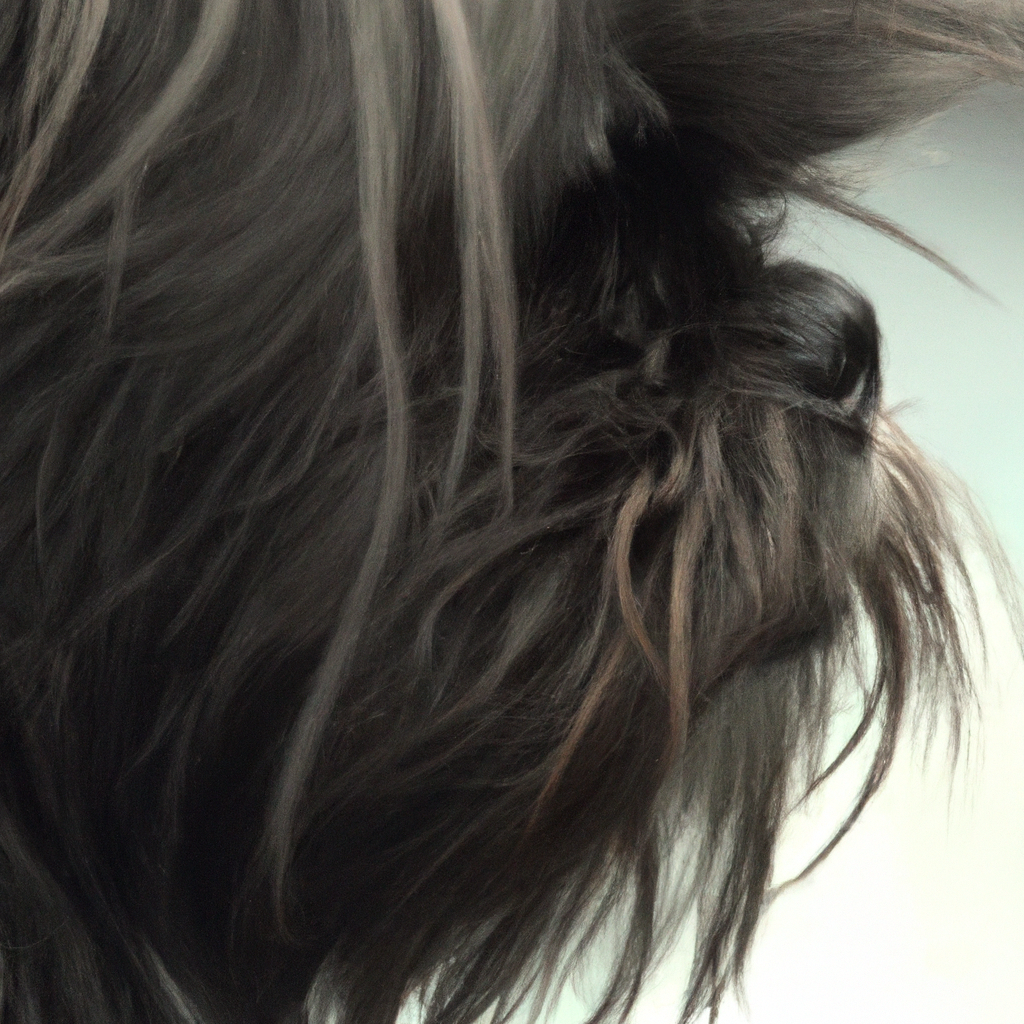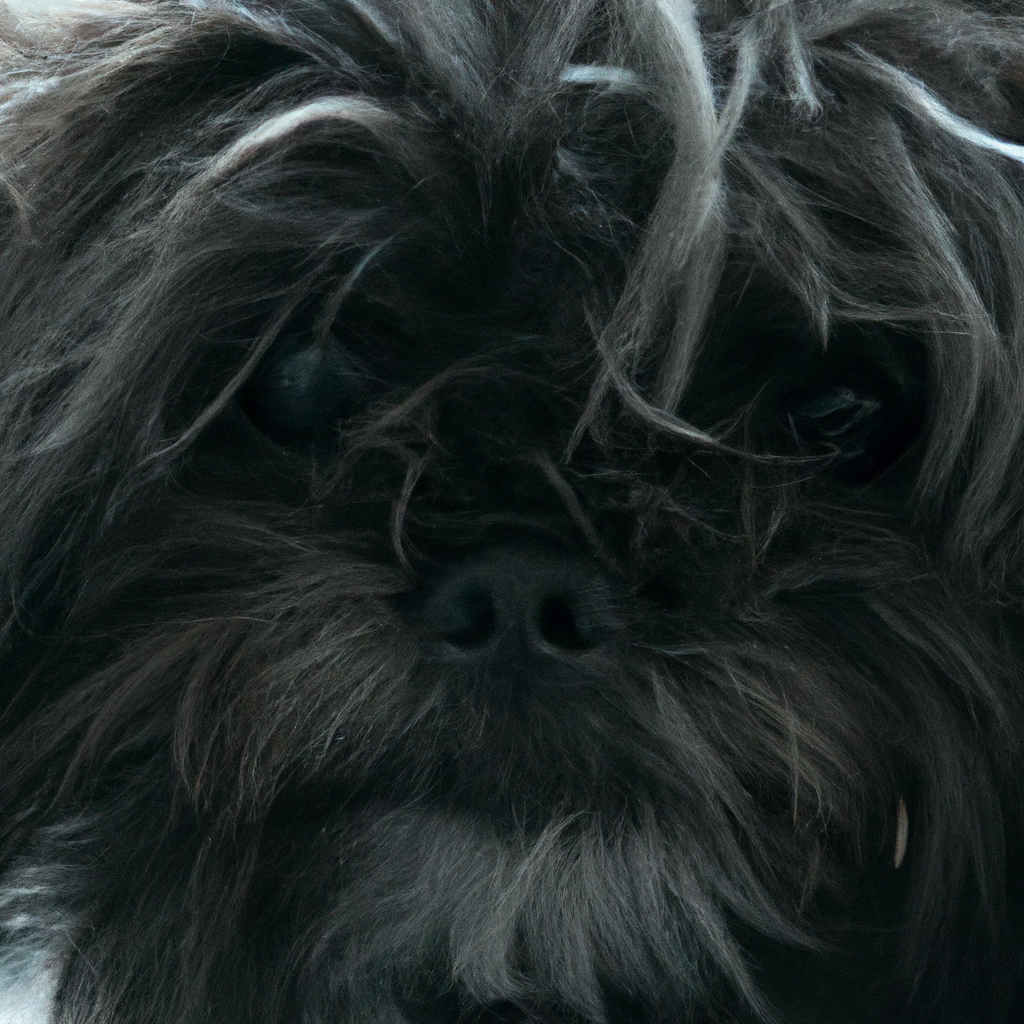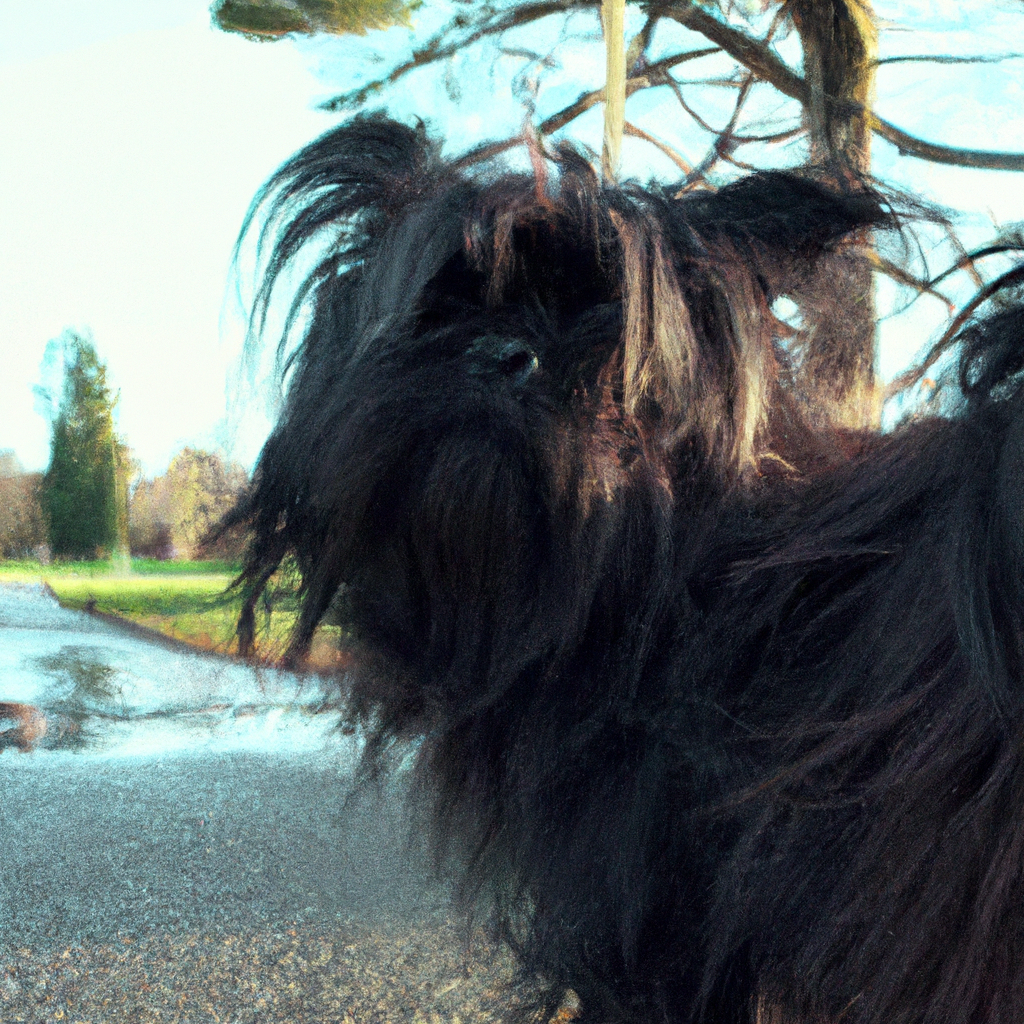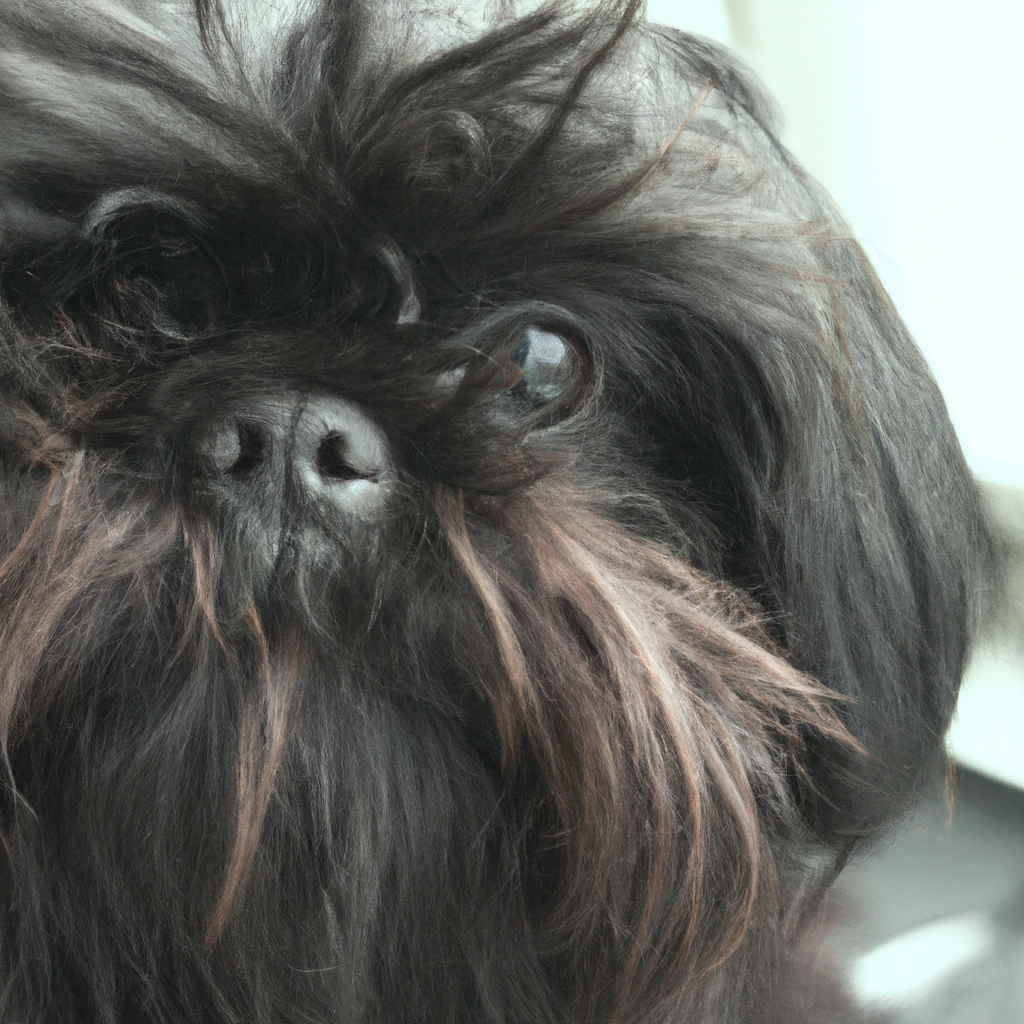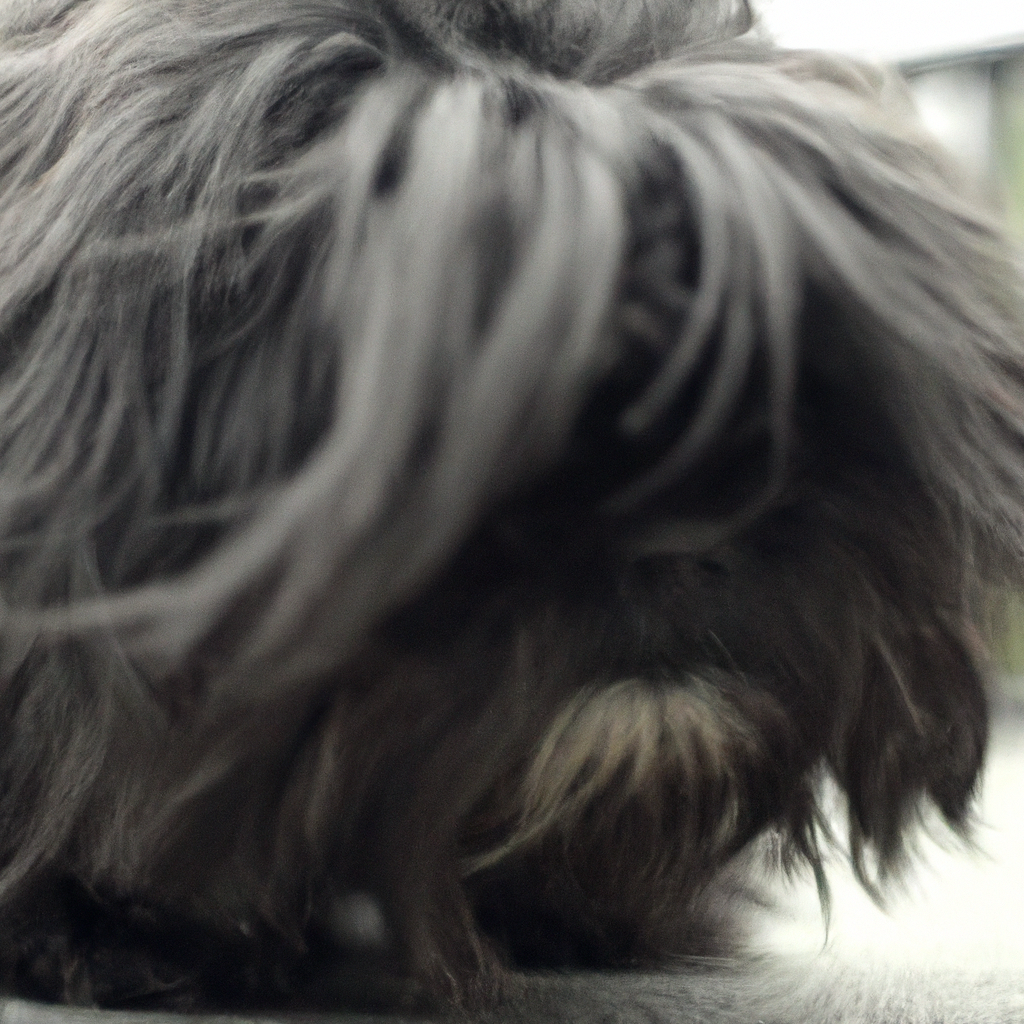Affenpinschers are small, compact dogs known for their distinctive “monkey-like” facial features, hence their name which translates to “monkey terrier” in German. They typically weigh between 6 to 13 pounds and stand about 9 to 12 inches tall at the shoulder. They have a dense, rough coat that comes in several colors, including black, gray, silver, red, tan, and beige. Their eyes are dark, round, and full of expression, while their ears can be either cropped or uncropped. Affenpinschers have a sturdy, square body with a deep chest and a level back. Their tail is usually docked and carried high. Overall, Affenpinschers are known for their bold, confident, and alert demeanor.
Understanding the Size and Weight of Affenpinschers
Affenpinschers, often referred to as “Monkey Terriers” or “Monkey Dogs” due to their distinct primate-like appearance, are a small but sturdy breed that originated in Germany. These dogs are known for their unique physical traits, which make them stand out in the canine world. Understanding the size and weight of Affenpinschers can provide a clearer picture of what to expect when considering this breed as a pet.
Affenpinschers are small dogs, but don’t let their size fool you. They are known for their robust and sturdy build, which is well-suited to their energetic and adventurous nature. Typically, an adult Affenpinscher stands between 9 to 11.5 inches tall at the shoulder. This height range makes them a perfect fit for the toy group, yet they are slightly larger and more robust than many other breeds in this category.
When it comes to weight, Affenpinschers usually tip the scales at around 7 to 10 pounds. Despite their small stature, they are far from fragile. Their compact, muscular bodies are designed for agility and endurance. This combination of size and strength makes them excellent companions for those who enjoy an active lifestyle, but also adaptable to more sedentary living conditions.
One of the most distinctive physical traits of Affenpinschers is their coat. They are covered in a thick, rough coat that gives them a somewhat shaggy appearance. This coat is typically black, but can also come in a variety of other colors including grey, silver, red, black and tan, or beige. Regardless of the color, their fur is dense and wiry, providing them with a good deal of protection against the elements.
Another notable feature of Affenpinschers is their face. They have a unique facial structure, with a flat face and a pronounced chin. Their eyes are round and dark, full of mischief and curiosity, while their ears can be either cropped or uncropped, standing erect or semi-erect. The overall effect is a comical, almost monkey-like expression, which is part of their charm and appeal.
Despite their small size, Affenpinschers are known for their fearless and confident demeanor. They are often described as having the personality of a much larger dog, packed into a compact, small-sized body. This makes them a great choice for those who want a small dog with a big personality.
In conclusion, the Affenpinscher is a small, sturdy dog with a distinctive appearance and a big personality. Their size and weight make them a good fit for a variety of living situations, from apartments to houses with yards. Their unique physical traits, including their rough coat and monkey-like face, add to their charm and appeal. Whether you’re an active individual looking for a companion to share in your adventures, or you’re simply seeking a loyal and entertaining pet, the Affenpinscher could be the perfect breed for you.
The Unique Coat and Color Variations of Affenpinschers
Affenpinschers, often referred to as “Monkey Terriers” or “Monkey Dogs” due to their distinct primate-like appearance, are a small but sturdy breed that originated in Germany. They are known for their unique physical traits, particularly their coat and color variations, which make them stand out among other breeds.
The Affenpinscher’s coat is one of its most distinctive features. It is dense, rough, and about one inch in length, giving the dog a shaggy but neat appearance. The fur is longer around the head and shoulders, creating a mane-like effect that adds to their monkey-like appearance. This breed is hypoallergenic, which means they are less likely to cause allergic reactions in people. This is because their hair, unlike fur, grows continuously and falls out less frequently, reducing the amount of dander they produce.
The Affenpinscher’s coat requires regular grooming to maintain its unique appearance. Brushing a few times a week helps to prevent matting and tangling. Despite their shaggy appearance, Affenpinschers do not shed excessively, making them a good choice for people who prefer a relatively clean and low-maintenance pet. However, they do require regular trimming to keep their coat looking its best.
In addition to their distinctive coat, Affenpinschers also have a wide range of color variations. While the most common color is black, Affenpinschers can also be gray, silver, red, black and tan, or belge, which is a mixture of red, black, and white hairs. Some Affenpinschers may also have white or silver hair mixed in with their primary color, particularly on their chest and neck.
The color of an Affenpinscher’s coat can sometimes change as they age. Puppies are usually born black and may lighten as they grow older. This is a normal part of the Affenpinscher’s development and is not a cause for concern.
The Affenpinscher’s unique coat and color variations are more than just physical traits; they are a part of the breed’s history and identity. The rough coat was likely developed as a form of protection against the harsh German climate, while the wide range of colors allowed the breed to blend into a variety of environments.
Despite their small size, Affenpinschers are known for their bold and confident demeanor. Their unique physical traits, combined with their lively personality, make them a popular choice among dog lovers. They are often described as having a “big dog” personality in a small dog’s body.
In conclusion, the Affenpinscher’s unique coat and color variations are just some of the traits that make this breed so special. Whether you’re drawn to their shaggy appearance, their hypoallergenic properties, or their wide range of colors, there’s no denying that Affenpinschers are a breed unlike any other. Their distinctive look, combined with their bold and confident personality, make them a truly unique and beloved breed.
Affenpinschers: A Closer Look at Their Distinct Facial Features
Affenpinschers, often referred to as “Monkey Terriers” or “Monkey Dogs,” are a unique breed of toy dogs that are known for their distinct facial features. These small, yet sturdy dogs have a face that is almost human-like, with expressive eyes and a mischievous grin that is sure to melt your heart.
The Affenpinscher’s face is one of its most distinguishing features. It has a round head with a pronounced stop, which is the point where the forehead meets the muzzle. The muzzle itself is short and blunt, giving the Affenpinscher a pug-nosed appearance. This breed has a broad, black nose with wide nostrils, and its lips are black and tight-fitting, adding to its distinctive facial expression.
One of the most captivating features of the Affenpinscher is its eyes. They are round, dark, and full of life, giving the dog an alert and curious expression. The eyes are set wide apart and are surrounded by a thick fringe of hair, which adds to the dog’s unique look. The Affenpinscher’s ears are equally expressive. They can be either cropped or uncropped, but regardless of the style, they are always alert and responsive to their surroundings.
The Affenpinscher’s coat is another defining feature. It is dense and rough, with a texture that is somewhat similar to that of a terrier. The coat is typically black, but it can also come in other colors such as grey, silver, red, or tan. The hair on the face is longer than the rest of the body, creating a mane that frames the face and gives the Affenpinscher its characteristic monkey-like appearance.
Despite their small size, Affenpinschers are sturdy and well-muscled. They have a square build, with a body that is as long as it is tall. Their legs are straight and strong, and their feet are small and round, with thick pads. The tail is usually docked and carried high, adding to the dog’s confident and lively demeanor.
Affenpinschers are not just about looks, though. They are also known for their lively and adventurous spirit. They are always on the move, exploring their surroundings with a keen sense of curiosity. Despite their small size, they are fearless and will not hesitate to stand up to larger dogs or threats. This makes them excellent watchdogs, despite their toy size.
In conclusion, the Affenpinscher is a breed that is full of character, both in terms of its physical traits and its personality. Its distinct facial features, coupled with its lively and adventurous spirit, make it a breed that is sure to bring joy and laughter to any home. Whether you are drawn to its monkey-like face, its expressive eyes, or its rough and ready coat, there is no denying that the Affenpinscher is a breed that stands out from the crowd. So, if you are looking for a small dog with a big personality, the Affenpinscher might just be the breed for you.
The Muscular Structure of Affenpinschers: A Detailed Overview
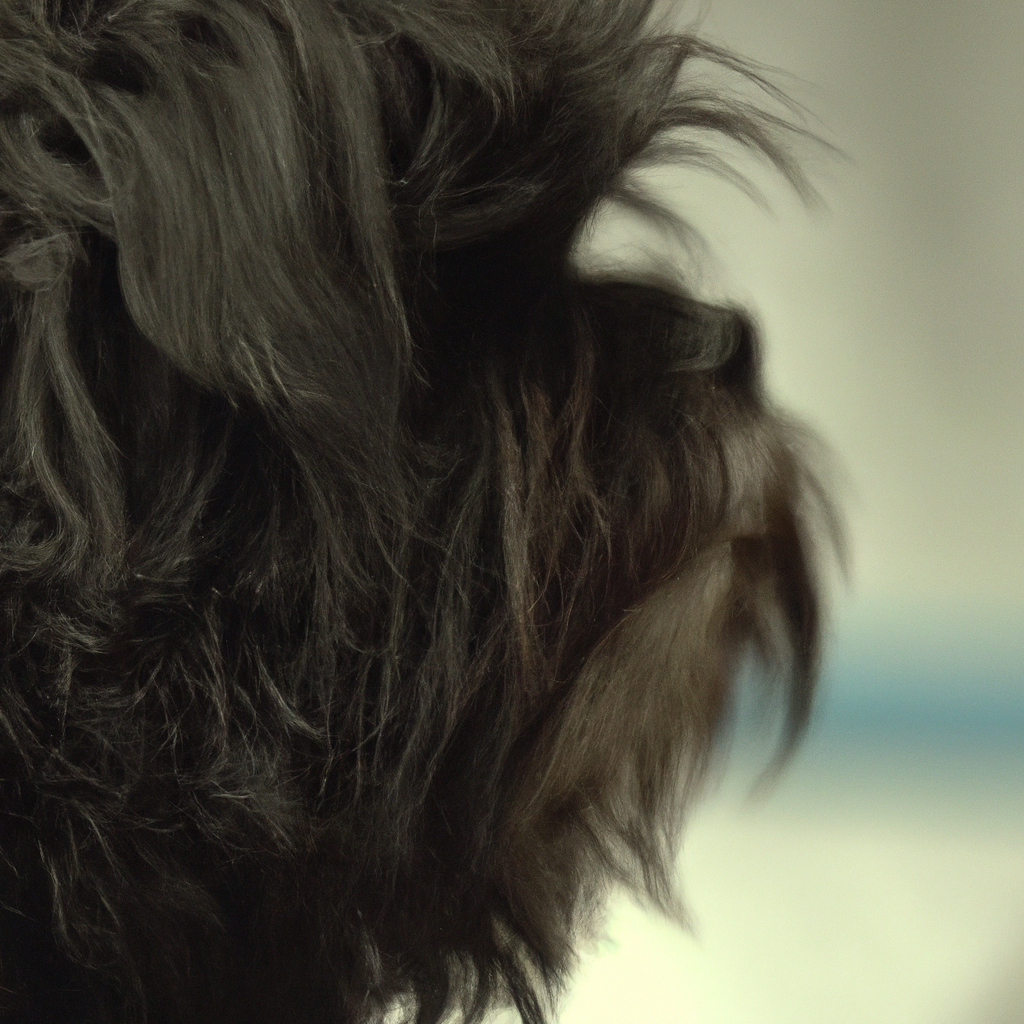
Affenpinschers, often referred to as “Monkey Terriers” due to their distinct primate-like appearance, are small but sturdy dogs with a unique muscular structure that sets them apart from other breeds. This article provides a detailed overview of the muscular structure of Affenpinschers, highlighting their physical traits that make them such fascinating creatures.
Affenpinschers are compact dogs, typically weighing between 7 to 9 pounds and standing about 9 to 12 inches tall at the shoulder. Despite their small size, they possess a robust and well-defined muscular structure that contributes to their agility and strength. Their muscular build is a testament to their origins as working dogs, bred to keep homes and stables free from rats and other pests.
The Affenpinscher’s muscular structure is most evident in its strong, straight legs. The front legs are set wide apart, providing a stable base for the dog’s body. The hind legs are equally muscular, providing the power needed for quick, agile movements. The thighs are well muscled, contributing to the breed’s ability to jump and climb with ease. The strong, well-developed muscles in their legs enable these dogs to be surprisingly agile and quick for their size.
The Affenpinscher’s body is compact and sturdy, with a broad, deep chest that houses a strong heart and lungs. The chest is well-muscled, providing protection for the vital organs and contributing to the dog’s overall strength. The back is short and straight, leading to a well-rounded, muscular rear. This muscular structure gives the Affenpinscher a confident, upright posture, further enhancing its monkey-like appearance.
The Affenpinscher’s head is proportionate to its body, with a broad, round skull and a short, blunt muzzle. The jaws are strong and muscular, capable of delivering a powerful bite if necessary. This is a remnant of their past as ratters, where a strong bite was essential for dealing with pests. The neck is short and thick, supporting the head and contributing to the dog’s overall strength.
The Affenpinscher’s muscular structure is covered by a thick, rough coat that adds to its distinctive appearance. The coat is typically black, but can also be grey, silver, red, or a mix of these colors. The hair on the face is longer than on the body, forming a mane that frames the face and gives the Affenpinscher its characteristic monkey-like look.
Despite their small size, Affenpinschers are known for their fearless, bold nature. Their muscular structure contributes to their physical abilities, but it’s their spirited personality that truly sets them apart. They are energetic, adventurous, and always ready for action. Their muscular build allows them to be active and playful, making them excellent companions for those who appreciate a lively, spirited dog.
In conclusion, the Affenpinscher’s muscular structure is a key aspect of its physical traits, contributing to its agility, strength, and distinctive appearance. This small but sturdy breed combines a robust muscular build with a spirited personality, making it a unique and fascinating breed. Whether you’re an Affenpinscher owner or simply a dog lover, understanding the muscular structure of this breed provides valuable insight into what makes these dogs so special.
Affenpinschers and Their Tail: What Makes It Unique?
Affenpinschers, often referred to as “Monkey Terriers” or “Monkey Dogs” due to their distinct primate-like appearance, are a unique breed of toy dogs that originated in Germany. They are known for their playful and adventurous nature, but what truly sets them apart is their physical traits, particularly their tail. The Affenpinscher’s tail is a defining feature that contributes significantly to their overall appearance and charm.
Affenpinschers are small but sturdy dogs, typically weighing between 7 to 9 pounds and standing about 9 to 12 inches tall at the shoulder. Despite their small size, they are known for their bold and confident demeanor. Their dark, shiny, and dense coat, which is usually black but can also come in other colors like grey, silver, red, or tan, gives them a distinctive look. But it’s their tail that often catches the eye and piques interest.
The Affenpinscher’s tail is usually docked, meaning it is shortened shortly after birth. This practice, which is common in several dog breeds, is done for various reasons, including perceived health benefits and conformity to breed standards. When docked, the Affenpinscher’s tail is typically about an inch to two inches long and stands erect, adding to their confident and alert appearance. It’s like a little flag that signals their readiness for action and adventure.
However, docking is not a universal practice. In many European countries, it is considered inhumane and is banned. In these regions, Affenpinschers are seen with their natural tails, which are longer and curve gently over their back. The natural tail also has its charm, giving the Affenpinscher a more relaxed and laid-back look. It’s interesting to note that the Affenpinscher’s tail, whether docked or natural, is always in motion, wagging enthusiastically to express their feelings.
The Affenpinscher’s tail is not just a physical trait; it’s also a communication tool. Like other dogs, Affenpinschers use their tails to express a range of emotions. A wagging tail usually indicates happiness or excitement, while a stiff, erect tail can signal alertness or aggression. By observing their tail, you can get a good idea of what your Affenpinscher is feeling.
In addition to its communicative function, the Affenpinscher’s tail also plays a role in balance. This is particularly important for this breed, given their energetic and adventurous nature. Whether they’re running around the house or exploring the outdoors, their tail helps them maintain stability and agility.
In conclusion, the Affenpinscher’s tail is a unique and important feature that contributes to their overall charm and appeal. Whether docked or natural, it enhances their appearance, aids in communication, and helps maintain balance. So, the next time you see an Affenpinscher, take a moment to appreciate their tail. It’s not just a physical trait; it’s a vital part of who they are.
The Role of Genetics in Affenpinschers’ Physical Traits
Affenpinschers, often referred to as “Monkey Terriers” or “Monkey Dogs” due to their distinct primate-like appearance, are a unique breed of toy dogs that have captured the hearts of many dog lovers worldwide. Their physical traits, which are largely influenced by genetics, are a fascinating subject to delve into.
Affenpinschers are small but sturdy dogs, typically weighing between 7 to 10 pounds and standing about 9 to 12 inches tall at the shoulder. Their compact size is a result of selective breeding, a process where specific dogs are chosen to reproduce based on certain desirable traits. In the case of Affenpinschers, breeders have historically favored smaller dogs, leading to the diminutive size we see today.
One of the most striking features of Affenpinschers is their rough, shaggy coat. This dense fur, which comes in colors ranging from black, grey, silver, red, to tan, and even a mix of these, serves as a protective layer against harsh weather conditions. The texture and color of their coat are determined by a combination of genes, each contributing to the overall appearance. For instance, the gene responsible for the black coat is dominant, meaning that it will typically override other color genes if present.
Their facial features are another aspect that sets Affenpinschers apart. They have round, dark eyes that are full of life and intelligence, a trait that is often associated with their curious and adventurous nature. Their ears can either be cropped to a point or left natural, folding over into a neat triangle. The shape of their ears, like many other physical traits, is influenced by genetics. Dogs with one or two copies of a particular gene will have ears that stand erect, while those without this gene will have floppy ears.
Affenpinschers also have a unique dental structure. Unlike most breeds, they have a slightly undershot jaw, meaning their lower teeth extend beyond the upper ones. This trait, which contributes to their distinctive monkey-like appearance, is a result of a genetic mutation. While in most breeds an undershot jaw would be considered a flaw, in Affenpinschers, it’s a breed standard.
Their tail is another feature shaped by genetics. Affenpinschers are born with a long tail, but in some countries, it’s customary to dock it to a short length. However, whether docked or not, the tail is usually carried high, adding to their confident and proud demeanor.
The role of genetics in shaping the physical traits of Affenpinschers is truly fascinating. It’s a complex interplay of dominant and recessive genes, each contributing to the unique appearance of this breed. From their size to their coat, facial features, dental structure, and even their tail, every aspect is a testament to the power of genetics.
However, it’s important to remember that while genetics play a significant role in determining the physical traits of Affenpinschers, environmental factors and overall health also have an impact. Proper nutrition, regular exercise, and routine veterinary care are essential in ensuring that these adorable dogs not only look their best but also live a long, healthy life.
In conclusion, the Affenpinscher’s physical traits are a delightful blend of genetics and careful breeding. These small but sturdy dogs, with their shaggy coats and monkey-like faces, are a testament to the fascinating world of canine genetics.
Affenpinschers’ Paws: An In-depth Analysis
Affenpinschers, often referred to as “Monkey Terriers” or “Monkey Dogs” due to their distinct primate-like appearance, are a small but sturdy breed that originated in Germany. These dogs are known for their playful and adventurous nature, but what often goes unnoticed is the unique structure of their paws. This article aims to provide an in-depth analysis of the physical traits of Affenpinschers, with a particular focus on their paws.
Affenpinschers are small dogs, typically weighing between 6 to 13 pounds and standing about 9 to 12 inches tall at the shoulder. Despite their small size, they are known for their robust and sturdy build, which is well reflected in their paws. The paws of an Affenpinscher are compact, round, and firm, providing them with a solid foundation that supports their active lifestyle.
The Affenpinscher’s paws are proportionate to their body size, with short, straight, and well-arched toes. This structure allows them to have a firm grip and balance, which is essential for their agile and energetic nature. The pads of their paws are thick and resilient, providing them with the necessary cushioning and protection for their adventurous escapades.
One of the most distinctive features of the Affenpinscher’s paws is their dark, strong, and short nails. These nails are not just for show; they serve a practical purpose. They help the Affenpinscher maintain traction on different surfaces, aiding in their agility and speed. Moreover, these nails are also used for digging, a common behavior among Affenpinschers.
The fur on the Affenpinscher’s paws is another notable feature. The fur is typically dense, rough, and shorter than the fur on the rest of their body. This type of fur provides an additional layer of protection for their paws, shielding them from harsh weather conditions and rough terrains. It also helps prevent dirt and debris from getting lodged between their toes, which could potentially cause discomfort or injury.
The Affenpinscher’s paws are not just functional; they also contribute to their overall appearance and charm. When viewed from the front, their paws turn slightly outward, giving them a unique stance that adds to their character. This stance, combined with their confident strut, often gives the impression of a small but fearless explorer, ready to take on the world.
In conclusion, the Affenpinscher’s paws are a remarkable blend of form and function. They are built to support the breed’s active and adventurous lifestyle, providing them with the necessary grip, balance, and protection. Moreover, they contribute to the Affenpinscher’s unique appearance and charm. So, the next time you see an Affenpinscher, take a moment to appreciate their paws. They are more than just cute; they are a testament to the breed’s strength, agility, and resilience.
The Lifespan and Health of Affenpinschers: A Physical Perspective
Affenpinschers, often referred to as “Monkey Terriers” or “Monkey Dogs” due to their distinct primate-like appearance, are a small but sturdy breed known for their playful and adventurous nature. This article will delve into the physical traits of Affenpinschers, focusing on their lifespan and health from a physical perspective.
Affenpinschers are a small breed, typically weighing between 6 to 13 pounds and standing about 9 to 12 inches tall at the shoulder. Despite their small size, they are known for their robust and sturdy build. They have a dense, wiry coat that comes in a variety of colors, including black, grey, silver, red, or a mix of these. Their dark, round eyes and bushy eyebrows give them an almost human-like expression, contributing to their monkey-like nickname.
One of the most striking physical traits of Affenpinschers is their lifespan. These little dogs are known for their longevity, with an average lifespan of 12 to 15 years. Some Affenpinschers have been known to live even longer, with proper care and a healthy lifestyle. This is quite impressive, especially when compared to other breeds of similar size.
However, like all breeds, Affenpinschers are prone to certain health conditions. While they are generally healthy dogs, they can be susceptible to specific genetic health problems. These include hip dysplasia, a condition where the thighbone doesn’t fit snugly into the hip joint, and patellar luxation, where the kneecap is dislocated from its normal position. Both of these conditions can lead to discomfort and mobility issues in Affenpinschers.
Another health concern for Affenpinschers is their dental health. Due to their small size, they have small mouths and teeth, which can lead to overcrowding and dental disease. Regular dental check-ups and teeth cleanings are essential for maintaining their overall health.
Heart disease is another concern for Affenpinschers. They can be prone to a condition called mitral valve disease, which affects the heart’s ability to pump blood effectively. Regular vet check-ups can help detect this condition early and manage it effectively.
Despite these potential health issues, Affenpinschers are known for their resilience and vitality. With proper care, regular vet check-ups, and a balanced diet, these dogs can lead long, healthy lives. Exercise is also crucial for this energetic breed. While they are small and can adapt well to apartment living, they still need regular physical activity to keep them fit and healthy.
In terms of grooming, Affenpinschers require moderate maintenance. Their wiry coat needs regular brushing to prevent matting and tangling. They are considered a hypoallergenic breed, which means they are a good choice for people with allergies. However, they do shed minimally, so regular grooming can help manage this.
In conclusion, Affenpinschers are a small but sturdy breed with a long lifespan and a few potential health concerns. They are generally healthy dogs, but like all breeds, they require regular vet check-ups and a balanced lifestyle to maintain their health. Their unique physical traits, combined with their playful and adventurous nature, make them a beloved breed for many dog lovers.Affenpinschers are small dogs with a sturdy, compact build. They typically weigh between 6 to 13 pounds and stand about 9 to 12 inches tall at the shoulder. They are known for their distinctive “monkey-like” facial features, including a short muzzle and prominent eyes. Their coat is dense and rough, usually black but can also be grey, silver, red, or tan. Affenpinschers also have a distinctive bushy tail that often curls over their back. Their ears can be either cropped to a point or left natural, in which case they fold over into a semi-circle. Overall, Affenpinschers are small but robust dogs with a distinctive, almost human-like expression.
